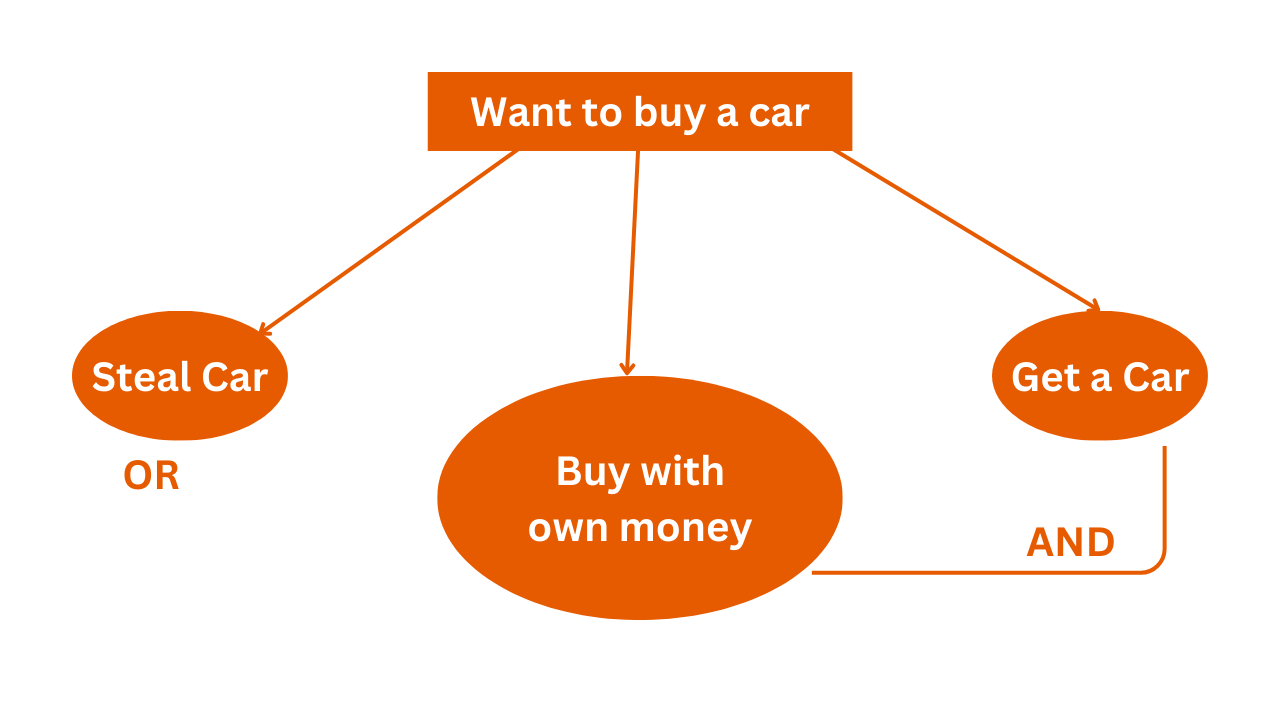Problem Reduction in AI
In artificial intelligence, problem reduction is the process of decomposing large, difficult problems into smaller, easier-to-manage subproblems to arrive at a solution. By breaking complex issues up into smaller, more manageable challenges, this method enables AI systems to take on bigger, more challenging tasks.
Problem Reduction Techniques in AI
A successful technique for simplifying difficult problems and making them simpler to address is problem reduction. It can also be applied to lessen the algorithms' complexity in terms of time and space.
An AND/OR graph can be used to depict the various ways a problem to reduced.
AND-OR graphs
When a problem can be solved by breaking it down into smaller problems that must all be solved, an AND-OR graph, also known as a tree, can be used to illustrate the solution.
We refer to the arcs produced by this breakdown or reduction as AND arcs. There can be an unlimited number of successor nodes pointed to by one AND arc. which after that needs to be resolved for the arc-to-point solution.
A method similar to best-first search that can suitably handle the AND arcs is required to identify a solution in an AND-OR network. We define FUTILITY, and we stop searching if the predicted cost of a solution exceeds its value. FUTILITY should be selected to match.
Example
Let’s understand the technique with the help of the following problem:

Problem Reduction Algorithm in AI
- The A* Algorithm
- The AO* Algorithm.
The A*Algorithm
To determine the shortest route between a beginning and a final point, a search method is used. It is a useful approach that is frequently applied to map traversal to determine the shortest path.
A* algorithm represents an OR graph algorithm that is used to find a single solution (either this or that). It is a computer algorithm which is used in path-finding and graph traversal.
It is used in the process of plotting an efficiently directed path between several points called nodes. In this algorithm, you traverse the tree in depth and keep moving and adding up the total cost of reaching the cost from the current state to the goal state and add it to the cost of reaching the current state.
The use of weighted graphs in the use of A* is another factor contributing to its effectiveness. Numbers are used in a weighted graph to indicate the costs associated with each path or course of action. This implies that the algorithms can determine the shortest way in terms of both time and distance, as well as the path with the lowest cost.

It uses a formula: F(n) = g(n) + h(n)
Algorithm of A*
The first step is to create an open list and a closed list.
At this point, the following actions must be taken:
Step 1. Enter the starting node in the OPEN list.
Step 2. If the OPEN list is empty return FAIL.
Step 3. Select the node from the OPEN list that has the smallest value (g + h).
if node = Goal, return success.
Step 4. Expand node "n" and generate all successors
Compute (g + h) for each successor node.
Step 5. If node "n" is OPEN/CLOSED, attach it to a back pointer.
Step 6. Go to step 3.
Advantages Of A* Algorithm
- A* algorithm solving complex problems.
- This algorithm is optimal and complete.
- It is the best search algorithm.
Disadvantages Of A* Algorithm
- It does not always produce the shortest path.
- In the A* algorithm complexity issues occur.
- It also requires memory.
The AO* Algorithm
AO* represents an AND-OR graph method that ANDs many branches to find multiple solutions. Similar steps are taken in this method, however, there are restrictions when following particular paths. As you follow those paths, the costs of every path that starts at the node before it are summed up to the point where you locate the desired state, no matter whether those paths get you there.

Algorithm Of AO*
Step 1. Set the graph's first node to
Step 2. Follow the current path across the network, adding nodes that haven't been expanded upon or solved yet.
Step 3. Choose one of these nodes, expand it, and call the value FUTILITY if it has no successors; otherwise, compute only f for each successor.
Step 4. Designate the node as solved if f = 0.
Step 5. Using backpropagation, change the value of f{ for the newly formed node to reflect its heirs.
Step 6. Use the most promising pathways whenever feasible, and if a node is marked as solved, mark the parent node as well.
Step 7. Stop if the initial node is solved or has a value higher than FUTILITY; if not, continue step 2 again.
Advantages of AO* Algorithm
- It is an efficient method to explore a solution path.
- It uses a divide-and-conquer strategy.
Disadvantages of AO* Algorithm
- This algorithm does not guarantee to give the optimal solution.
- Implementing AO* can be more complex than simpler algorithms due to its adaptability and nature.


